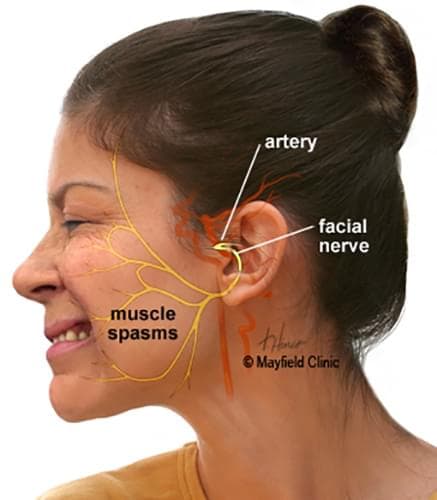Hemifacial Spasm
Tyler Neurosurgical Associates specializes in hemifacial spasm diagnosis and treatment
Hemifacial spasm is a nervous system disorder that causes one side of the face to twitch involuntary. There are a number of different treatment options available for someone who is experiencing hemifacial spasms, depending on the situation of each person. Hemifacial spasms often start with a twitch in the eyelid that can continue to spread and lead to a complete closure of the eye. If you are experiencing these symptoms, the Tyler Neurosurgical team will help you understand your diagnosis and explore what treatment options are best for you.
Hemifacial spasm occurs in two forms: typical and atypical. Typically, the twitching will start in the lower eyelid and continue to spread to the entire eyelid, possibly affecting the rest of the muscle in the lower face. Over time, the muscles on one side of the face will start to be pulled down into a permanent frown.
They atypical form happens when the spasms start lower in the face and progress upwards to the eye, although this is less common.
Hemifacial spasm disorder occurs in both men and women, more frequently affecting middle-aged and older women, who experience symptoms at almost twice the rate of men. This condition is somewhat rare and is only seen in approximately 11 out of 100,000 people.


Common Symptoms of Hemifacial Spasms
Essential Tremors symptoms and signs:
The most common and persisting symptom of hemifacial spasm is the spasm (twitch) itself. These symptoms usually only occur on one side of the face, but in rare cases, there are spasms on both sides. Symptoms may include:
- Small twitching of one eyelid, causing the eye to shut and tear up
- Spasms on one side of the face, affecting the cheek and mouth
- Pain behind the ears
- Hearing changes
- Larger spasms going from the eye to the chin

Causes of Hemifacial Spasms
Hemifacial spasms is a disorder that can be caused by a number of different things, an injury to the facial nerve, a tumor or blood vessel compressing the nerve, Bell’s palsy, or there may be no apparent cause. The most common cause of hemifacial spasm is a blood vessel pressing the facial nerve where it exits the brainstem.
What treatment options are available to Tyler Neurosurgical patients?
There are a number of different ways to treat hemifacial spasms, including Microvascular Decompression Surgery (MVD). Our team at Tyler Neurosurgical Associates can help relieve you of any problems that you may be experiencing. If you are looking for relief for your hemifacial spasm diagnosis Tyler Neuro can help you with a proper treatment plan.

